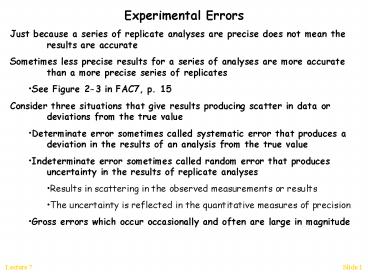Experimental Errors - PowerPoint PPT Presentation
1 / 9
Title:
Experimental Errors
Description:
Sometimes less precise results for a series of analyses are more ... Bias in reading an instrument. Number bias - preference for certain digits. Lecture 7 ... – PowerPoint PPT presentation
Number of Views:62
Avg rating:3.0/5.0
Title: Experimental Errors
1
- Experimental Errors
- Just because a series of replicate analyses are
precise does not mean the results are accurate - Sometimes less precise results for a series of
analyses are more accurate than a more precise
series of replicates - See Figure 2-3 in FAC7, p. 15
- Consider three situations that give results
producing scatter in data or deviations from
the true value - Determinate error sometimes called systematic
error that produces a deviation in the results
of an analysis from the true value - Indeterminate error sometimes called random error
that produces uncertainty in the results of
replicate analyses - Results in scattering in the observed
measurements or results - The uncertainty is reflected in the quantitative
measures of precision - Gross errors which occur occasionally and often
are large in magnitude
2
- Experimental Errors
- Determinate Errors are inherently determinable or
knowable - Instrumental errors are produced because
apparatus is not properly calibrated, not clean
or damaged - Electronic equipment can often give rise to such
errors because contacts are dirty, power
supplies degrade, reference voltages are
inaccurate, etc. - Method errors result from non-ideal behavior of
reagents and reactions used for analysis - Interferences
- Slowness of reactions
- Incompleteness of reactions
- Species instability
- Nonspecificity of reagents
- Side reaction
- Personal errors involve the judgement of the
analyst - Bias in reading an instrument
- Number bias - preference for certain digits
3
- Experimental Errors
- Effect of determinate errors on the results of an
analysis - Constant error example Suppose there is a -2.0
mg error in the mass of A containing 20.00 A - Examine the effect of sample size on A
calculated - The result is that for a constant error, the
relative quantity of A approaches the true value
at high sample masses.
4
- Experimental Errors
- Effect of determinate errors on the results of an
analysis - Proportional error example Suppose there is a
5 ppt relative error in the mass of A for a
sample thats 20.00 in A - Effect of sample size on A
- The A is independent of sample size if a
proportional error of constant size exists in
the mass of A
5
- Experimental Errors
- Mitigating determinate errors
- Instrument errors can be reduced by calibrating
ones apparatus - Personal errors can be reduced by being careful!
- Method errors can be reduced by
- Analyzing standard samples
- The NIST has a wide variety of standard samples
whose analyte concentrations are well
established - The effect of interferences can often be
accounted for by spiking the analytical sample
with a known quantity of analyte or performing a
standard additions analysis - The effect of the interferences on the added
analyte should be the same as that on the
original analyte - Independent analysis of replicates of the same
bulk sample by a well proven method of
significantly different design can check for
determinate errors - Blank determinations may indicate the presence of
a constant error - Carry out the analysis on samples that contain
everything but the analyte - Vary the sample size in order to detect a
constant error
6
- Experimental Errors
- Gross errors - such as arithmetic mistakes, using
the wrong scale on an instrument can be cured
by being careful! - Indeterminate or random errors producing
uncertainty in results - Arise when a system is extended to its limit of
precision - There are many, often unknown, uncontrolled,
opportunities to introduce small variations in
each measurement leading to an experimental
result - One way to examine uncertainty is to produce a
frequency distribution - Example examine the frequency distribution for a
measurement that contains four equal sized
uncertainties, u1, u2, u3, u4 - The combinations of the us give certain numbers
of possibilities
7
This data are plotted in Figure FAC7 3-1, p 22.
8
- Experimental Errors
- One way to examine uncertainty is to produce a
frequency distribution - If the number of equal sized uncertainties is
increased to 10 - only 1/500 chance of observing 10u or -10u
- If the number of indeterminate uncertainties is
infinite one expects a smooth curve - The smooth curve is called the Gausian error
curve and gives a normal distribution - Conclusions about the normal distribution
- The mean is the most probable value for normally
distributed data - This is because the most probable deviation from
the mean is 0 (zero) - Large deviations from the mean are not very
probable - The normal distribution curve is symmetric about
the mean - The frequency of a particular positive deviation
from the mean is the same and the same sized but
negative deviation from the mean - Most experimental results from replicate analyses
done in the same way form a normal distribution
9
- Experimental Errors
- Examine the data for the determination of the
volume of water delivered by a 10.00 mL transfer
pipet - FAC7, Table 3-2, p. 23 and Table 3-3,
p. 24 and Figure 3-2, p. 24 - 26 of the 50 results are in the 0.003 mL range
containing the mean - 72 of the 50 measurements are within the range
1s of the mean - The Gaussian curve is shown for the smooth
distribution having the same ss and the same
mean as this 50 sample set of data































